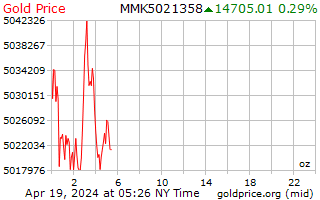Conversion : 1 troy ounce = 31.1034768 grams
Could not show charts
Gold Price Myanmar
Myanmar is officially known as the Republic of the Union of Myanmar, but it is often referred to as Burma. Located in Southeast Asia, Myanmar is a sovereign state that shares borders with India, Bangladesh, Thailand, Laos and China. The nation has a significant amount of coastline on its southern edge, along the shores of the Bay of Bengal and the Andaman Sea. The capital of the country is Naypyidaw, while the nation’s largest city is Yangon. The official language of the country is Burmese, and its government is a unitary parliamentary constitutional republic.
The official currency of Myanmar is the Burmese Kyat. The first kyat was issued from 1852 to 1889, and was denominated in both gold and silver until 1889. The second kyat was issued from 1943 to 1945 and was introduced during the Japanese occupation. The currency eventually became worthless at the end of the war at which time the Burmese Rupee was introduced in 1945. The third kyat was finally introduced in 1952 and is still in use today. This currency replaced the rupee at par, and also allowed for decimalisation of the currency into 100 smaller units called pya.
The Burmese Kyat is issued and controlled by the Central Bank of Myanmar. The nation’s central bank was established in 1948 and is headquartered in Naypyidaw. The central bank not only manages the country’s currency but is also tasked with maintaining financial stability and supervision of the financial sector.
If you are looking to buy gold in the nation or simply want to see current spot gold prices, they will likely be quoted in kyat. Quotes may also be available in other key global currencies such as U.S. Dollars, euros, Japanese Yen or Great British Pounds. Gold prices are typically quoted by the ounce, gram or kilo, although sometimes local measures of weight may also be used.
Myanmar has numerous natural resources, many of which are largely untapped. The nation reportedly has numerous gold deposits, and the government reportedly earned a significant sum from exports of gold and other base metals during the 90s. The majority of Myanmar gold is consumed by Asia, and this makes sense given the fact that two of the nation’s neighbors, India and China, are two of the largest consumers of gold in the world. Myanmar has been referred to as the “Golden Land” as the yellow metal is used for domestic as well as religious purposes.
Myanmar’s gold reserves as well as its reserves of tungsten, copper, jade and oil have attracted foreign investment in recent years. Recent activities in the region, however, have drawn some criticism from environmentalists and others. Poor and unsafe working conditions, low pay and lax regulations all pose significant hurdles to the country reaching its mining potential.
If the nation’s recently elected democratic government is able to get a handle on the country’s resources and put more regulatory guidelines and infrastructure in place, the nation could potentially see a major boom in mining and hopefully much of the potential wealth that is discovered will benefit not only the companies involved but the people of the region.









